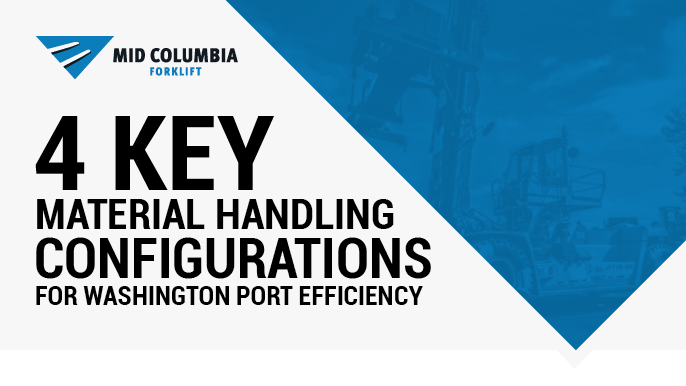4 Key Material Handling Configurations for Washington Port Efficiency
by , on December 16, 2019 at 6:30 AM
 Washington State is home to 75 ports, making it the most trade-dependent state in the US. In addition to international shipping functions, Washington ports operate marinas, intermodal facilities, socks, airports, and other key functions around the state. Handling the huge volume of goods and materials being delivered into Washington requires dependable equipment to move heavy loads.
Washington State is home to 75 ports, making it the most trade-dependent state in the US. In addition to international shipping functions, Washington ports operate marinas, intermodal facilities, socks, airports, and other key functions around the state. Handling the huge volume of goods and materials being delivered into Washington requires dependable equipment to move heavy loads.
A proper port operation will rely on a variety of cranes, shuttles, and gantries to offload and stack heavy shipping containers. But to keep things working at top efficiency, port operations must include heavy material handling equipment in their fleets. Key configurations include:
Reachstackers
Reachstackers help optimize port and intermodal operations by expediting staging areas of shipping containers. These heavy pieces of equipment like the Kalmar DRG450-65 S5X can stack shipping containers up to six high and four rows deep, even when loaded with 92,000 pounds of product.
Terminal tractors
Terminal tractors provide an essential function by delivering containers quickly and efficiently to staging and stacking areas. Models like the Kalmar TR618i are built to handle harsh weather conditions at seaside ports while delivering optimum fuel efficiency and hauling performance.
Roll-on Roll-off forklifts
Roll-on Roll-off (RORO) forklifts are specialized designs that feature high carrying capacity in super-low profiles. These design features allow RORO equipment to enter low doorways on ships to remove containers from within. Models like the Kalmar DCE330RORO can maneuver up to 72,000 pounds of product in narrow spaces, making it an essential piece for many port operations.
Masted container handlers
Masted container handlers are a powerful solution for container management. Whether utilizing an empty container handler to manage large stacks of empty containers awaiting products before being shipped out or stacking containers loaded up to 99,000 pounds five high with the Kalmar DCG-410CSG, the right masted solution can improve your staging and product management.
Straddle carriers
For port operations in need of versatile equipment to meet a variety of needs, straddle carriers like the Kalmar HSC460 can complete a variety of work from ship to shore. Boasting capacities of up to 120,000 pounds, straddle carriers are available in diesel, electric, and hybrid configurations, and can even be configured for automation to improve throughput for businesses with lower manpower.
Environmentally friendly port equipment solutions
Just because you’re moving tens of thousands of pounds, doesn’t mean you have to ignore environmental impacts. Electric and hybrid-drive technologies are available in higher capacities than ever (including the Kalmar Super Gloria Reachstacker) and can not only reduce your business’s carbon footprint, but also your overall operational fuel costs. Port automation software such as Kalmar TLS and terminal operating systems can provide further impacts to reduce your overhead and optimize operations.
Ultimately, the key to your port equipment is how each piece of your fleet works together to get the job done. Adding the right mix of container handlers, reach stackers, terminal tractors, and other specialized equipment can help speed up your operation and reduce overhead costs over the long-term. Contact us to see what types of solutions our heavy equipment experts recommend to meet your unique business use case.




